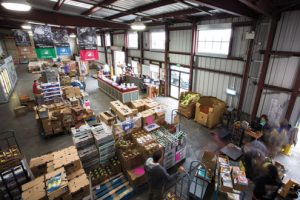Providing Food Through Local Groups With Deep Roots
By Chris Ryan

These three residents have little in common except a connection to one of the biggest local organizations whose name you probably know but whose reach few people appreciate.
Second Harvest Food Bank in Watsonville distributes food throughout the County, but its reach far exceeds its own efforts. By working with its network of nearly 100 local pantries, shelters, group homes, churches, after-school groups, and other organizations, Second Harvest provided needed food and nutrition to 50,000 people in 19,000 households in September alone.
By connecting with established groups with deep roots in their own neighborhoods, Second Harvest reaches five times the number of households they can help directly themselves. Each year this amounts to tens of thousands more children, veterans, mothers, elderly, and so many others just needing a helping hand during a tough time.
“Once they start learning how to use nutrition to help their bodies feel good and to help with their health problems, they have a better feeling inside overall, which helps them to participate more, [and] be productive in their daily lives,” said Melinda Brown, Treatment Technician.
Second Harvest has sourced, stored, and distributed food across the community for decades – but it’s only through the reach of groups like Janus that a box of fresh, local produce can serve as a practical lesson in cooking and nutrition to a group of determined mothers and then a healthy communal meal.
Just a couple of miles away, in a common room at DeLaveaga Elementary School, people are gathered for a short class about nutrition, exercise, and eating habits. Nutrition Ambassador Elvia Lopez hands out round paper plates and pens and asks the parents — mostly mothers, some with children in their laps — to draw the sizes of portions they typically serve to their families.
It’s a great entrée to a discussion on healthy choices and portion control, positive habits that make real gains against chronic health problems like obesity and diabetes.
After the short class — more like a social, info-sharing session among neighbors – the parents take some of the fresh vegetables waiting in boxes on a long table in the back of the room to cook up back home.
Luz Serna, a local mother, found out about the classes through an announcement one of her children brought home from school. Since coming to the classes, Serna has picked up helpful tips on preparing better meals for her family. Her children are now eating more fruits and vegetables. Her young ones like it, she says (they learned early); her older ones are “a little more difficult,” she conceded, but they still eat them.
Many like Serna who participate in the program — Passion For Produce — aren’t starting from zero when it comes to cooking. Most of the Mexicans and Salvadorans who make up a large portion of the classes at this site are already skilled cooks, part of culinary traditions passed down from their own parents. Often it’s about making “the same food more healthy,” Lopez, the class facilitator, pointed out. Or discovering unknown connections between specific foods and healthier outcomes. Serna herself learned that black beans have a lot of protein, a useful insight due to her anemia.
This year the Passion For Produce classes will reach 1,300 families at 34 sites and distribute over one million pounds of produce. “Every time, new people come – new face, new face, new face,” Lopez told me. At one time, she was one of them. She ate better, lost weight, and was identified by the coordinator as a star student. Now she’s teaching the class.
“When you’re doing something good,” said Lopez, “you’re an example for the community. And the people follow you and listen to you, and [say], ‘Ah, if she can do it, I can do it too.’”
Visit Second Harvest at www.thefoodbank.org. You can watch a short video of one of our clients telling her story at www.thefoodbank.org/january.
•••
Copyright © Chris Ryan. All rights reserved.